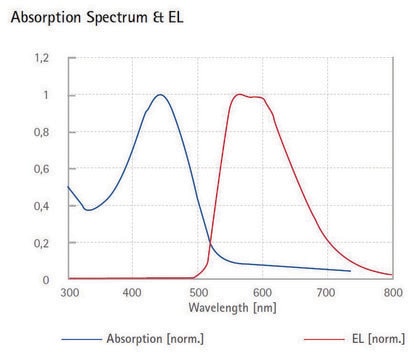Products may be shipped at a different temperature than the recommended long-term storage temperature. If the product quality is sensitive to short-term exposure to conditions other than the recommended long-term storage, it will be shipped on wet or dry-ice. If the product quality is NOT affected by short-term exposure to conditions other than the recommended long-term storage, it will be shipped at ambient temperature. As shipping routes are configured for minimum transit times, shipping at ambient temperature helps control shipping costs for our customers. For more information, please refer to the Storage and Transport Conditions document: https://www.sigmaaldrich.com/deepweb/assets/sigmaaldrich/marketing/global/documents/316/622/storage-transport-conditions-mk.pdf
推荐产品
描述
Band gap: 2.3 eV
分子量
average Mn 40,000-70,000
荧光
λex 493 nm; λem 554 nm in toluene
轨道能量
HOMO -5.3 eV
LUMO -3 eV
OLED设备性能
ITO/PEDOT:PSS/MEH-PPV/Al
- Color: orange-red
- Max. Luminance: 220 Cd/m2
- Max. EQE: 0.3 %
- Turn-On Voltage: 3.8 V
ITO/PEDOT:PSS/MEH-PPV/PBO/Al
- Color: orange-red
- Max. Luminance: 970 Cd/m2
- Max. EQE: 1.9 %
- Turn-On Voltage: 2.9 V
ITO/PEDOT:PSS/MEH-PPV/PBZT/Al
- Color: orange-red
- Max. Luminance: 1400 Cd/m2
- Max. EQE: 2.5 %
- Turn-On Voltage: 2.8 V
OPV设备性能
ITO/MEH-PPV/BBL/Al
- Short-circuit current density (Jsc): 1.98 mA/cm2
- Open-circuit voltage (Voc): 0.93 V
- Fill Factor (FF): 0.47
- Power Conversion Efficiency (PCE): 1.1 %
ITO/MEH-PPV:PC61BM(1:4)/Ca
- Short-circuit current density (Jsc): 2 mA/cm2
- Open-circuit voltage (Voc): 0.8 V
- Fill Factor (FF): 0.25
- Power Conversion Efficiency (PCE): 1.5 %
Mw/Mn
~6
储存温度
2-8°C
SMILES字符串
O(CC(CCCC)CC)c1cc(c(cc1)OC)C=C
InChI
1S/C17H26O2/c1-5-8-9-14(6-2)13-19-16-10-11-17(18-4)15(7-3)12-16/h7,10-12,14H,3,5-6,8-9,13H2,1-2,4H3
InChI key
CTUSWJPWMNVXEE-UHFFFAOYSA-N
相关类别
一般描述
储存分类代码
11 - Combustible Solids
WGK
WGK 3
闪点(°F)
Not applicable
闪点(°C)
Not applicable
个人防护装备
Eyeshields, Gloves, type N95 (US)
商品
PCBM-based n-type semiconductors - Find p- and n-type organic semiconductors available with PCBM library & properties.
PCBM-based n-type semiconductors - Find p- and n-type organic semiconductors available with PCBM library & properties.
PCBM-based n-type semiconductors - Find p- and n-type organic semiconductors available with PCBM library & properties.
PCBM-based n-type semiconductors - Find p- and n-type organic semiconductors available with PCBM library & properties.
-
How is shipping temperature determined? And how is it related to the product storage temperature?
1 answer-
Helpful?
-
-
How can I determine the shelf life / expiration / retest date of this product?
1 answer-
If this product has an expiration or retest date, it will be shown on the Certificate of Analysis (COA, CofA). If there is no retest or expiration date listed on the product's COA, we do not have suitable stability data to determine a shelf life. For these products, the only date on the COA will be the release date; a retest, expiration, or use-by-date will not be displayed.
For all products, we recommend handling per defined conditions as printed in our product literature and website product descriptions. We recommend that products should be routinely inspected by customers to ensure they perform as expected.
For products without retest or expiration dates, our standard warranty of 1 year from the date of shipment is applicable.
For more information, please refer to the Product Dating Information document: https://www.sigmaaldrich.com/deepweb/assets/sigmaaldrich/marketing/global/documents/449/386/product-dating-information-mk.pdfHelpful?
-
-
do you have molecular weight characterization data for your Poly[2-methoxy-5-(2’-ethylhexyloxy)-1,4-phenylene vinylene] samples?
1 answer-
As listed in the 'PROPERTIES' section, the average molecular weight of this product is 40,000-70,000.
Helpful?
-
-
What is the glass transition temperature (Tg) of Product 541443, Poly[2-methoxy-5-(2-ethylhexyloxy)-1,4-phenylenevinylene]?
1 answer-
Unfortunately, the glass transition temperature (Tg) is not determined for this product.
Helpful?
-
-
What is the solubility of Product 541443, Poly[2-methoxy-5-(2-ethylhexyloxy)-1,4-phenylenevinylene]?
1 answer-
Per our quality control testing, this product is soluble in toluene with heat and sonication at a concentration of 0.02 g/L.
Helpful?
-
-
Does Product 541443, Poly[2-methoxy-5-(2-ethylhexyloxy)-1,4-phenylenevinylene], contain a dopant?
1 answer-
This product does not contain a dopant.
Helpful?
-
-
What is the Department of Transportation shipping information for this product?
1 answer-
Transportation information can be found in Section 14 of the product's (M)SDS.To access the shipping information for this material, use the link on the product detail page for the product.
Helpful?
-
-
Can Product 541443, Poly[2-methoxy-5-(2-ethylhexyloxy)-1,4-phenylenevinylene], efficiently convert light to electricity?
1 answer-
The polyphenylenevinylene (PPV) polymers themselves do not convert light to electricity very efficiently. They need to be blended with an electron transport material. The best material for this is a fullerene material called [6,6]-Phenyl C61 butyric acid methyl ester (PCBM, offered as #684430, 684449, 684457). There are several references that discuss polymer-fullerene heterojunctions. One paper on this subject is Brabec, C.J.; et. al. Applied Physics Letters, 80, 1288 (2002).
Helpful?
-
Active Filters
我们的科学家团队拥有各种研究领域经验,包括生命科学、材料科学、化学合成、色谱、分析及许多其他领域.
联系客户支持![聚[2-甲氧基-5-(2-乙基己氧基)-1,4-亚苯基亚乙烯] average Mn 70,000-100,000](/deepweb/assets/sigmaaldrich/product/structures/344/488/b8f8179d-3970-4deb-a754-adda88cdb36f/640/b8f8179d-3970-4deb-a754-adda88cdb36f.png)
![聚[(对苯乙炔)-alt-(2-甲氧基-5-(2-乙基己氧基)-对苯乙炔)]](/deepweb/assets/sigmaaldrich/product/structures/147/963/61b421da-530b-4acf-8851-ecb9492e90ba/640/61b421da-530b-4acf-8851-ecb9492e90ba.png)

![聚[(9,9-二正辛基芴基-2,7-二基)-alt-(苯并[2,1,3]噻二唑-4,8-二基)] average Mn ≤25000](/deepweb/assets/sigmaaldrich/product/structures/428/661/1c4ebb98-9d51-48c0-96c7-e556ca425aa4/640/1c4ebb98-9d51-48c0-96c7-e556ca425aa4.png)
![聚[(间苯乙炔)-co-(2,5-二辛氧基对苯乙炔)] light-emitting polymer, predominantly trans](/deepweb/assets/sigmaaldrich/product/structures/249/040/9442b889-4fa0-4b4a-b424-cff0769a5ef2/640/9442b889-4fa0-4b4a-b424-cff0769a5ef2.png)




